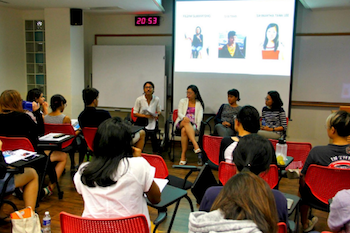-
Advocacy Theme
-
Tags
- Abortion
- Adoption
- Caregiving
- CEDAW
- Disability
- Domestic Violence
- Domestic Workers
- Harassment
- Healthcare
- Housing
- International/Regional Work
- Maintenance
- Media
- Migrant Spouses
- Migrant Workers
- Muslim Law
- National budget
- Parental Leave
- Parenthood
- Polygamy
- Population
- Race and religion
- Sexual Violence
- Sexuality Education
- Single Parents
- Social Support
- Sterilisation
- Women's Charter
Film screening of “Desert Flower”: Exploring the topic of female genital mutilation
October 25th, 2017 | Children and Young People, Gender-based Violence, Muslim Women's Rights, News, Sexual and Reproductive Health, Views
By Reetaza Chatterjee, GEC Volunteer
 On 13 October 2017, I attended an event organised by the Singapore Committee for UN Women in collaboration with Engaging Africa at the National University of Singapore to discuss the topic of Female Genital Mutilation (FGM). The event kicked off with a screening of “Desert Flower”, a film based on the international best-selling novel of the same name by Waris Dirie, which tells Dirie’s inspirational story of growing up in a nomadic goat-herding family in Somalia, becoming one of the world’s most sought-after supermodels and subsequently being appointed a United Nations spokesperson for the elimination of FGM.
On 13 October 2017, I attended an event organised by the Singapore Committee for UN Women in collaboration with Engaging Africa at the National University of Singapore to discuss the topic of Female Genital Mutilation (FGM). The event kicked off with a screening of “Desert Flower”, a film based on the international best-selling novel of the same name by Waris Dirie, which tells Dirie’s inspirational story of growing up in a nomadic goat-herding family in Somalia, becoming one of the world’s most sought-after supermodels and subsequently being appointed a United Nations spokesperson for the elimination of FGM.
A lively panel discussion on FGM in the Singapore context followed, led by three speakers: AWARE representative and coordinator for a campaign for Muslim women’s rights, Gender Equality IS Our Culture (GEC), Filzah Sumartono; feminist writer, Sya Taha; and clinical sexologist, Dr Martha Tara Lee. Many in the audience were under the impression that FGM is essentially an “African problem”. It was eye-opening for me to find out that FGM, or sunat perempuan, as it is known locally, is also practiced in the Malay community in Singapore.
Sunat perempuan is usually carried out on girls before the age of two and is classified under the World Health Organization’s (WHO) classification as FGM Type I or FGM Type IV. According to Filzah, there are currently 6 private clinics in Singapore that offer this service for around $20 to $35 – but this is not widely known about outside the Malay community. Currently, there is no law banning the procedure.
Speakers explored how the term Female Genital Mutilation is politically loaded in itself. Merriam-Webster dictionary’s definition of ‘mutilation’ is to damage something severely, especially by violently removing a part. However, some within the Malay community prefer to use terms such as “female circumcision” or “cutting”, which do not come with the connotation of violence. Sya mentioned that from her conversations with young parents about the issue, most mothers and pregnant women either perceive sunat as a positive or do not really question the practice – it is seen as a rite of passage of sorts, something that just “needs to be done”, similar to male circumcision.
Dr Lee shared about how the trauma of male circumcision, especially when carried out on minors at a very young age, affects brain development and may hinder the body’s ability to experience pleasure in the future. While this was known research for male circumcision, she added that she “was sure that this would be similar for FGM”.
In the past, religious scholars and leaders cited sunat perempuan as a way to “ennoble the women” and “ensure that she is not aroused too easily”. This mindset still remains in the present day where the procedure is seen to prevent her from becoming “wild”. Filzah made a pertinent point about sunat perempuan essentially hypersexualising a child – the need to control a girl’s ability to express their sexuality at such a young age shows that she is already being viewed as a sexual being and this is being done at the expense of her rights to health, physical and emotional well-being and bodily autonomy.
Sya also spoke about the increasing number of young mothers who have done their research on sunat perempuan and do not wish to do it to their daughters. However, there still remains a lot of community pressure from older relatives and religious circles for parents to have their daughter undergo the procedure as a marker of Malay-Muslim identity, despite there being no mention of female circumcision in the Quran. This pressure is usually the greatest during the point of birth of the child and young mothers may either not have the support from their husbands to oppose the practice or may not know anyone who does the same.
It is only through community engagement that greater awareness can be raised on the issue, which will equip young parents with the knowledge to make an informed decision for the well-being of their children.



